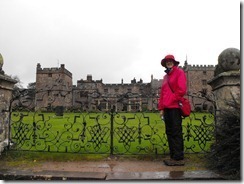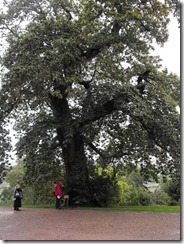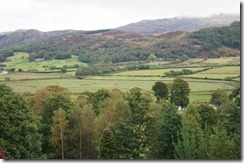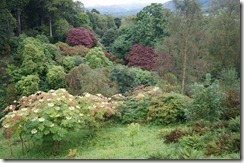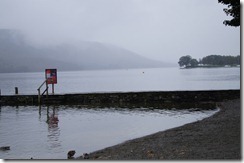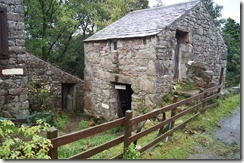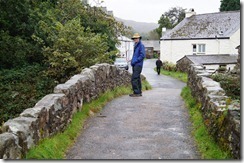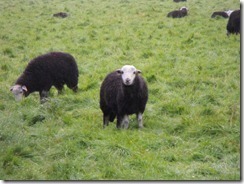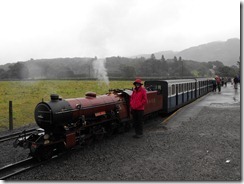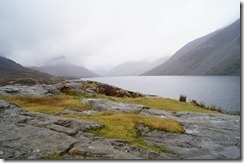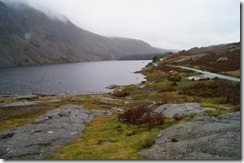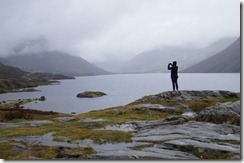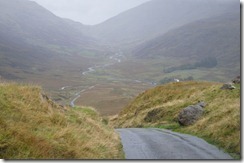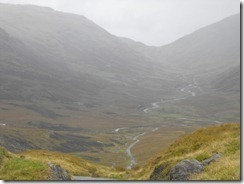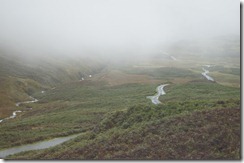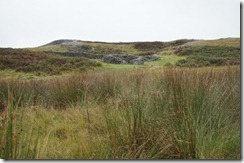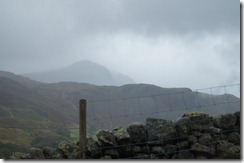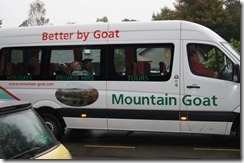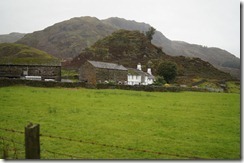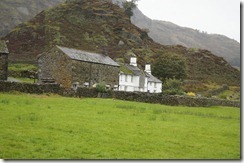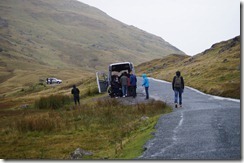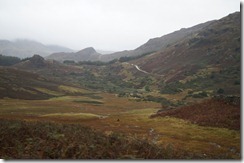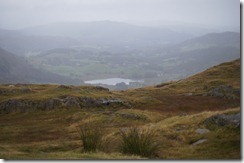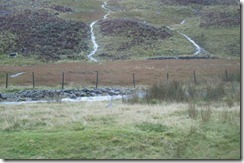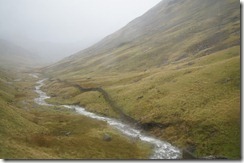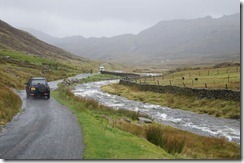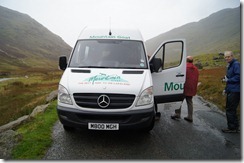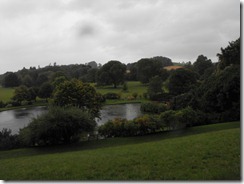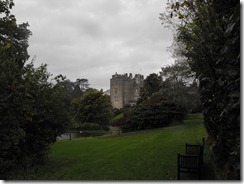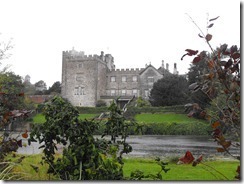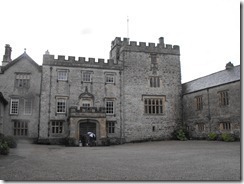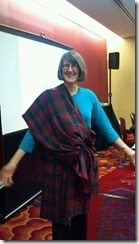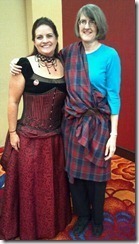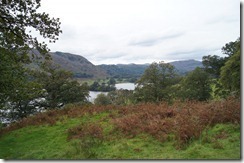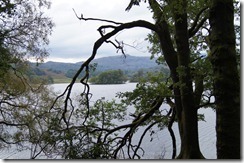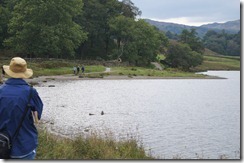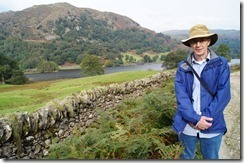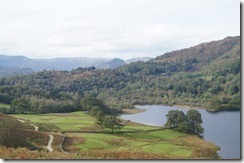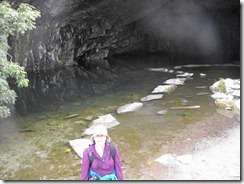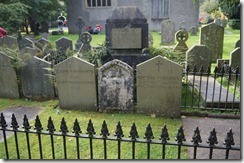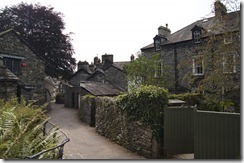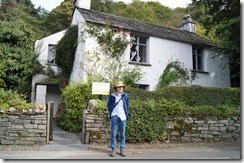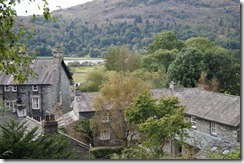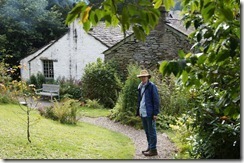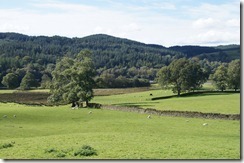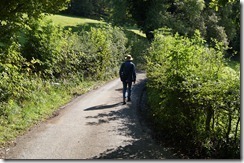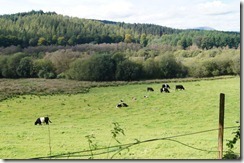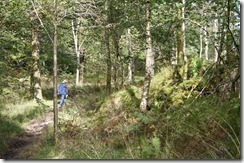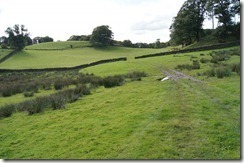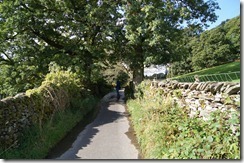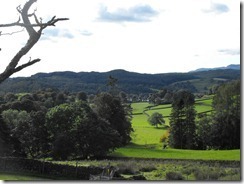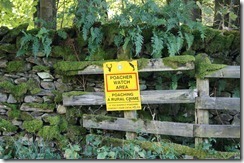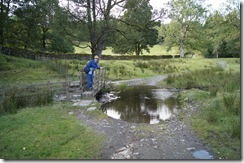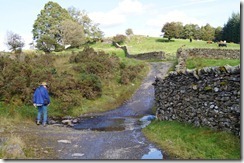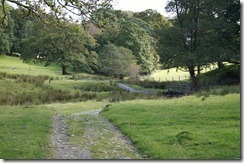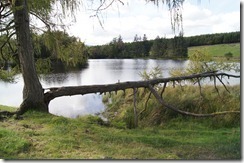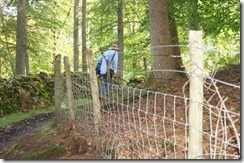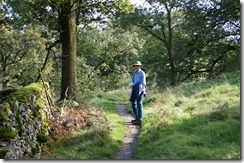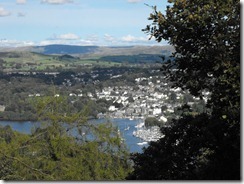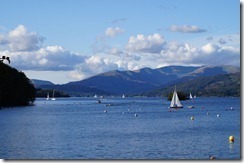Sally MacKenzie's Blog, page 7
October 29, 2012
Mountain Goat, part 4
Our next stop was Muncaster, and here I confronted my main problem with tours. My purpose in signing up for this excursion was to see Muncaster, yet we had only about one and a half hours to cover everything—house, gardens, and World Owl Centre—nowhere near enough time. So I had to make some hard choices. I concluded I couldn’t do the house justice in such a short stay—and the weather was wet, so the gardens weren’t really an option—so I went for the owl show.
As part of my compromise, Mr. M and I did scamper over to take some photos of the castle and buy the house guidebook so I could see what I was missing. Here I am with the castle. Sadly the hat/coat clash is rather evident, so I apologize for offending anyone’s color sensibilities.
And another picture.
Reading through the guidebook—which was written by one of the family—it sounds like there was a pack rat (or even a hoarder) somewhere in the family tree. Of course, I understand completely. Imagine having all that room! No need to weed out possessions--much easier just to stick another box off in a corner. (Reminds me a little of a scene in my Bedding Lord Ned, actually.) Of course, when they rummage around in their basement, they come upon some priceless treasure! I just find old crayons and orphaned board game pieces.
Muncaster Castle is reputed to be haunted, so I guess it’s appropriate to be posting this close to Halloween. One of the ghosts is Thomas Skelton, or Tom Fool. The story, which you can find here, is that he would sit under a chestnut tree and, when asked directions, would send anyone he didn’t like off to follow the path down to the quicksand. Creepy!
Here I am, under Tom’s tree.
This is one of the views, looking out from about this point. I particularly liked the bridge, but I don’t know its significance, if any.
I also took a picture of a bit of one garden that was near the castle.
We then went off to learn about owls. I can’t say the program was terribly extensive, but it was fun—and we learned something that we could apply when we got back home. They had two owls at the presentation—and clearly I should have taken their pictures. One they described as a flying feather duster. He looked quite stout—but he was mostly feathers.
The tidbit we learned? That sometimes baby owls will fall out of their nests. You should leave them alone—they’ll be fine. If you bring them home, they will think they are people. And when the are returned to the wild, they will attack people, thinking they are competing for their territory. When we got back to the States, we read an article in the newspaper about a jogger who was attacked by an owl when he was out jogging two days in a row—and this was exactly the explanation.
After the show, we toured the owl center. It was a little hard to get good pictures—I’m not much of a photographer, so the fences defeated me—but I took plenty of pictures anyway. We weren’t quite sure what was up with the owl on the right. We thought he might be wet—but his companion isn’t having such a “bad feather” day.
And of course I couldn’t resist trying to get a picture of the tiny owl.
From Muncaster Castle, we headed back to Windermere and Bowness. We stopped for another photo opportunity at Coniston Water.
Mr.M took my picture—how nice of them to coordinate the sign with my hat.
One of our last stops—Malcolm pulled off the road, but we didn’t get out—was Yew Tree Farm. It played “Hill Top” in the movie Miss Potter, which neither Mr. M nor I had seen. (We got it via Netflx shortly after we got home.) The other interesting story Malcolm told us about the place had to do with its “spinning gallery.” It was the unmarried women's job to make thread. Instead of using a spinning wheel, they would drop the fiber from the spinning gallery--at least I think that's what he said--and this is where the term “spinster” came from. According to this site and this one, there is a link between spinning thread and the tem for an unmarried woman.
That’s it for the Mountain Goat tour. Next up will be one of my favorite sites, Levens Hall.
October 28, 2012
Battening down the hatches
I feel the weather sites are starting to channel their inner Chicken Little, but I guess they must know what they are talking about. In any case, it is definitely better to be prepared for disaster and have disaster not arrive than the other way round. So I've got my bread, milk, and tp. I'm printing out the book I'm currently working on (Ash's story), so I can do some revisions even if our power goes out.
Speaking out Ash's story, I've been concentrating on that recently, but I plan to get back to our Lake District adventures--assuming the sky hasn't fallen once Sandy moves on.
Stay safe, everyone!
October 25, 2012
Mountain Goat, part 3
After leaving the Roman fort and Hardknott, we headed to Boot in Eskdale for a lunch stop. Mr. M and I weren’t in need of lunch. When we are off on our rambles, we usually have a large-ish breakfast and then a bigger than normal (for us) dinner. But Mr. M wished to try out the local ale, so we went into the pub at Brook House Inn so he could have a pint and I could have a hot chocolate. A picture of the inn:
After our beverages, we went out to have a look at the old mill. This is apparently the stables—I didn’t get a good picture of the mill, but if you follow the link, you can see pictures and read about it.
We didn’t tour the mill. Mr. M felt we were running low on time and wanted to get back to the van. Here he is on the pack horse bridge, giving me his standard “stop taking pictures and come along" look.
Behind the pub, Mr. M discovered a flock of Herdwick sheep and persuaded one to pose for a picture…well, Mr. M used his telephoto.
According to Malcolm, our guide, Herdwick sheep are the only sheep that change color over their lifetime. They are born black, turn brown after a year or so, and eventually turn gray or white—though they have the white legs and face earlier, as you see in the picture. If they live that long. Again according to Malcolm, they are mostly bred for their meat, their wool being too wiry to be used for clothing. The lambs are, ahem, selected for our dinner plates before their fleece turns brown.
We encountered sheep all over the Lake District. Herdwicks are special to the area, and Beatrix Potter is credited with doing much to save them and the Lake District from developers. There have apparently been efforts to breed them elsewhere now; if another disease such as foot-and-mouth were to strike, it could wipe out the breed if Herdwicks are concentrated in just one area.
I was very impressed that Malcolm could identify the gender of the sheep we saw—until he told us that only the ewes are allowed to graze free. The rams are kept in “bachelor flocks.” (Found that on Wikipedia here.) Another interesting thing about the Herdwicks—they learn at an early age to stay in their home territory or “heaf.” (You can read more about that if you follow the link.)
After we left Boot, we took a ride on the Ravenglass & Eskdale Steam Railway from Boot to Irton Road. It’s Victorian, so not my period, but it was fun nonetheless. You can read its history here. They have videos on the official site of the trains in motion, but there’s quite a collection of videos on youtube as well. Here’s one. I asked Mr. M to take a picture of me posing with our engine so you can see the scale of the train.
I was glad that I’m not a particularly large person when we got into the car—there’s not a lot of room. If we’d had to share with another couple, it would have gotten dicey. I have no idea where we would have put our legs.
We then moved on to Wastwater, the deepest of all the Lake District lakes. If you check out the link, you’ll see mention of the Screes. Here is Mr. M’s picture.
Wastwater was very beautiful. I suppose we would have seen more if the clouds weren’t so low, but they did add a dramatic touch.
That’s Mr. M in blue, but I have to admit I don’t know what that structure is.
Looking one way
and looking the other.
Yes, I got a little camera happy, but, as you know if you followed the link, Wastwater was voted Britain’s most beautiful view. The figure in the picture above is one of the other two Americans, a mother and daughter from the other Washington.
I think there’s only one more Mountain Goat adventure to come.
October 23, 2012
Mountain Goat, part 2
We went over two mountain passes on our trip—the Wrynose and the Hardknott—and I’m afraid I’ve sort of gotten confused over which is which and what pictures I took of them. I think some of my pictures in the previous post may have been taken on or after we drove over the Wrynose pass.
If you follow the Wrynose link, above, you’ll see a picture of the Three Shires Stone. (Don’t overlook the first picture—see all the sheep in the shade? We didn’t notice sheep doing that, but maybe that’s because a good part of our trip was chilly and rainy. No need to seek shade.) I do remember our guide, Malcolm, telling us about this stone. He said it made sense before the government reorganized the British counties. Before the reorganization, Lancashire, Westmorland, and Cumberland met at the stone; now they are all part of Cumbria. Here’s a bit on the stone, and if you follow the links, you’ll see more about the passes.
We did take a few pictures of those roads. As I remember, Malcolm had to get a running start with the van to make it up. See the road winding off into the distance?
Here’s a picture Mr. M. took. Look for the car’s headlights. (You'll probably have to click on the picture to enlarge it.)
I think this might be on the other side of the pass. You can see the clouds were low that day.
From time to time in our travels, we were following the old Roman road. Once we got over Hardknott pass, we came upon the old Roman fort.
The fort is the circle of stones—hmm or maybe that’s the bath areas. If the weather had been better, we would have stopped and poked around, but, alas, that was not to be. However, you can read a bit about it and see some pictures here. Malcolm pointed out this was probably not a plum posting—too remote and too cold.
At various points along this part of the drive, Malcolm was hoping we could see Scafell Pike, the highest mountain in England, but the clouds were too low. Here is some mountain. I don't know which one it is, but it's not Scafell.
Yet more Mountain Goat adventures to come.
October 22, 2012
Mountain Goat, part 1
I am not a fan of tours. I, rightly or wrongly, think I’ll be crammed in with a bunch of Americans to see stuff that doesn’t fit my (perhaps narrow) interests. For example, Brantwood, John Ruskin’s home, is in the Lake District, but it’s Victorian. If I had unlimited time, I might visit it, but with a tight schedule, it doesn’t’ make the cut. Wray Castle, also Victorian, also not on the list.
But I wanted to see Muncaster Castle and taking one of the Mountain Goat tours was the only way to do that, so we reluctantly signed up for this tour. I’m so glad we did! It was well worth the time and price. And somewhere along the line—maybe when we were signing up—I learned that only about 10 percent of visitors to the Lake District are Americans. I do know the woman who took our reservation said they get a lot of older British folks who don’t want to drive. According to Malcolm, our guide/driver, they have a number of repeat customers. And since each guide has his or her own interests, the basic tour outline gets embellished in many different ways. You can learn different things even if you take the same tour again, but with a different driver. (Mr. M. thought Malcolm’s “bias” was economics.)
The Mountain Goat van picked us up at our B&B. We happened to be the first of Malcolm’s stops, so we sat up front and got a chance to chat with him a little. I can’t remember where he was from originally—not, I think, the Lake District, but somewhere in northern England—but he spent 30 years teaching elementary school in Scotland. Doing Mountain Goat tours is his retirement job. He told us many of the guides are retired from other careers.
Once our van was full—only two other Americans aboard—we headed out. I couldn’t remember why I took this photo.
Until I looked at the closer shot.
This is Fell Foot Farm in Little Langdale.
Not too far into the trip, we stopped for a coffee break.
and photo shoot.
We think this lake is Elterwater.
Mr. M has a telephoto function on his camera.
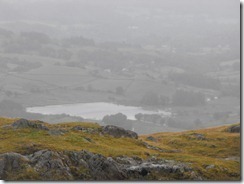
We took the tour on Tuesday, the day after the big rain. We had a little rain during the tour and a little flooding, and the clouds were low so we didn’t get the great views we would have had on a clear day, but we did get to see a lot.
As we drove along, Malcolm pointed out small streams that had formed because of all the rain.
You may have to look closely to see them. There’s one on the left, just above the rocks, and another, longer one on the right. Here are some more that are much easier to spot.
There’s a heron—though it may be hard to see—in the center of the picture, just below the fence. He—or she—was the reason I took the shot. And above the fence to the left, the things that might look a little like dogs with dark coats and white faces are Herdwick sheep.
I realized that we’d encountered a few of these little impromptu streams on our hikes. I think they form because the ground is so rocky, the water just runs off any way it can after a rainstorm. Here’s another view, just because I like it.
Malcolm stopped the van again so those of us eager to take pictures could get out and do so. I took the opportunity to get a shot of two cars that had passed us while we were stopped. Notice the width of the road.
Here’s a front view of our Mountain Goat. Mr. M is looking at me, I think indicating that I should stop taking pictures and get into the van, for goodness sakes. The balding fellow in the red jacket is our guide, Malcolm.
More of our Mountain Goat adventure to come.
October 20, 2012
Sizergh Castle
We had three days left in the Lake District, and we had to plan them carefully. I wanted to see Sizergh Castle, Muncaster Castle, and Levens Hall. We could take the bus—or, as the English seem to call it, the stagecoach (how Regency!)—to Sizergh and Levens Hall, but the only way to reach Muncaster was by taking a tour. There is a bus that goes there from Windermere, but it only runs during the summer.
And then there’s the weather. You have to plan for rain when you go to the Lake District, and we’d had some, though it was usually pretty light and intermittent. But the weather reports were calling for serious rain. I wanted to see Levens Hall on a nice day—you’ll see why later—so that left Sizergh Castle and the tour for the iffier weather days.
As predicted, the day we went to Sizergh Castle was rainy, but I was prepared. I had a rain coat and rain pants, a rain hat and waterproof hiking boots. I did make one error—I should have used my daughter-in-law Beth’s backpack that has a rain cover, but it’s somewhat boxy, so I took my backpack instead. Fortunately, I put my camera in a plastic bag. I suggested Mr. M wear his rain pants. He declined, and then was very sorry he didn’t take my advice. Turns out we’d chosen the rainiest day in 30 years to head out to Sizergh Castle. (That’s what the news reports said. There was heavy flooding in some parts of the country, particularly Yorkshire, to the east of the Lake District.)
We caught the bus from Bowness to the Windermere train station where we had to change buses to head southeast toward Lancaster. The bus was about 20 minutes late, but at least we had a covered area where we could wait. We changed bus drivers in Kendal, and Mr. M asked the new driver to let us know when we should get off—the stop wasn’t too far from Kendal. And then we had to slog up the drive to the castle—but first we took a detour to check out Low Sizergh Barn. Looking on the map, I couldn’t figure out how Lower Sizergh connected to the castle—they seem to be on opposites sides of the highway (A591). Which they are, but I didn’t notice when we were walking since you go under the highway to travel between them. We saw cows and produce, but we didn’t linger. I was hoping to make it to the castle in time for the house tour.
Sadly, we missed the tour, though Mr. M said he thought we needed reservations, so we might not have gotten on it even if we’d been on time. I bemoaned our bad luck, telling the folks we bought our tickets from that the bus was 20 minutes late. That didn’t solve the house tour problem, but it turns out we got tickets for free drinks because we’d taken public transportation! I had a mocha and Mr. M, already a bit damp, had a hot chocolate. And then, crazy Americans that we are, we ventured out to view the gardens. The folks working the gift shop were quite amused.
I never took my camera out of my bag, and Mr. M only took a few pictures because of the rain. He took a shot of the lake.
And then the castle from the lake.
And a closer view of the caste.
Looking over the guidebook now, I’m not too unhappy that we missed the gardens as it sound like most of them are 20th century additions. Lovely, I’m sure, if you' are into gardens, but not so fascinating if you are more interested in all thing Regency or older.
Mr. M also took a picture of the front of the castle.
The front door is where the person with the umbrella is.
The docent in the entrance hall told us they’d had terrible flooding a few years ago and had had to take up the floor to dry it out and then try to reassemble it. As you might guess, if there’s a lot of rain, it can all flow down the yard and under the door. (We visited Sizergh on Monday. When we were at Levens Hall on Wednesday, we learned Sizergh had been closed on Tuesday for flooding—I don’t know that it flooding that actually came into the house—so we were very lucky we planned our excursions as we did.)
One of the interesting bits about the castle: since the Strickland family was Catholic, they fled England with James II in 1688 (according to the guidebook). However, through some wise arrangements, they was able to protect the castle from being seized, so when they returned, they could take ownership again.
One of the docents, hearing our accents, pointed out that there were a couple American connections to the castle. Mr. M remembers something about George Washington, but he can’t quite recall the details. The other was, if I’m not getting this wrong, Lady Edeline Sackville, who married Sir Gerald Strickland was the daughter of the 7th Earl of De La Ware—Delaware. My ears pricked up when I heard her name—the Sackvilles own Knole, one of the estates we visited when we were in England two years ago.
A Strickland (or now a Hornyold-Strickland—the family tree is rather challenging for this American, at least, to follow) still lives at Szergh Castle. I’m pretty sure the docent said that, at Christmas, the family all comes back and all the rooms are used, including the ones we were touring. As the mother of four sons, I have to admit I looked around at all the historical furnishings and shuddered. But, on the other hand, it is wonderful that the house is still a house and not merely a museum.
October 17, 2012
NJRWA 2012 conference
I took the train up to the New Jersey RWA Put Your Heart in a Book conference on Friday. I love taking the train—I get off at Metropark, the stop before NYC. I can usually get a fair amount of work done, and I had page proofs for Surprising Lord Jack as well as some blogs to write. Well, I got some proofreading done, but no blogging, as you might have noticed. And the train was standing room only—literally, at least for a while. I think an earlier train had run into difficulties, so we got some extra folks that way.
As the train doors opened at Metropark, I saw Janet Mullany in the car next to me. (I always go for the Quiet Car, so I couldn’t chat anyway. I had to work on those page proofs.) It was such a great surprise to see her standing there, though I did know she was coming—she gave her workshop on British servants. My pal Rebecca Lamb gave us both a ride to the hotel and we caught up on things. There’s never any shortage of conversation at a romance writers conference!
I decided to go to the conference at almost the last minute when I found out my novella, “The Duchess of Love,” was a finalist in the Golden Leaf. However, I was certain my friend, Caroline Linden, would win—so certain I made her send me an acceptance speech when she asked me to accept for her if her novella was chosen. I practiced the speech all afternoon—and then about fell over in a dead faint when I heard the incomparable Anne Frazier Walradt read a selection from my story.
I always bring a camera to conferences, but never manage to take any pictures. Roni Denholtz, also a finalist, snapped a shot of my happy amazement.
Saturday I went to a great workshop by Julia London—10 Things I Wish I’d Known. It’s always hard making choices among the workshops, but I hadn’t had the chance to hear her speak before. I was nodding my head in agreement on many of her points.
After Julia’s talk, I went to hear Kim Killion and Eliza Knight present “Corsets, Codpieces, and Kilts—Oh, My!” (Now tell me you wouldn’t have gone to something with that title, too…) It was a double workshop—two periods—and covered a lot of ground. Fun—and I got to chat with my friend, Elena Greene, who I hadn’t hadn’t seen in ages. AND I got wrapped in a kilt—or maybe it was a plaid. I don’t write Scottish historicals, so I’m a little fuzzy on all the distinctions—even though Kim and Eliza tried to explain.
Here I am, all kilted (or plaided) up—though I'm pretty sure this is not the MacKenzie plaid.
And here I am with Kim—she looks rather elegant, don’t you think? But I suspect her costume was rather more uncomfortable than mine.
After lunch I met up with my agent, Jessica Faust. We sat and talked for close to two hours I think—I was almost late to the book signing.
And as to the book signing…I was so scatterbrained when I signed up for the conference—I was still trying to get Jack in order and plan for our impending two week trip to England—that I totally forgot to sign up to sign! I didn’t figure that out till long past the last minute. But the bookseller was able to find a couple books and I brought a few from home, so all was not lost. I was just happy to have a place at the table to meet readers and chat with my fellow authors.
After dinner with the wonderful Nancy Herkness, Mary Jo Putney, and Nina Paules of eBook Prep (whom, it turns out, I’d met a number of years ago at a Regency event in Maryland), I spent a little time at the after party. Those Jersey girls sure know how to dance!
October 11, 2012
The Coffin Trail and Rydal Water
I read about the Coffin Trail in a guidebook before we left the States. That’s a more pleasant name, I think, than Corpse Road which these paths are sometimes called. (Here’s an article about a walk that includes a corpse road in a different part of the Lake District.)
So why do these trails have such ghoulish names? Not every village had a church and not every church had a graveyard, so when someone died, their coffin—or corpse—had to be carried to wherever the nearest graveyard was. Folks in Ambleside carried their dead along the Coffin Trail to St. Oswald’s in Grasmere. As we left Dove Cottage, we came upon the Coffin Stone where the men would pause to rest their burden. We noticed the stone because we were again on the verge of getting lost and so got to talking to a couple who was on the trail with us and they pointed it out. It turned out that the man’s relatives used to live just up from Wordsworth and knew him, and the man periodically comes back to see the house, though his family no longer owns it.
Unfortunately, I neglected to get a picture of the Coffin Stone, even though the woman very obligingly offered to pose on it for us.
We followed the path—or a path—for a while, heading toward Rydal. Here’s a picture of Rydal Water.
We ended up at the road that led past Rydal Mount. In retrospect, it might have been possible to do both Dove Cottage and Rydal Mount in one day, but I’m happy with the way we did it. For one, the day we saw Rydal Mount was rainy, so not a good day to be hiking along a rocky path. And for another, I don’t know about Mr. M, but I can’t absorb too much history at one time. Seeing the two houses on separate days helped me remember them better.
And we weren’t done hiking. I’d read an article in the Lakeland Walker (Mr. M had stopped to buy some wine, so I bought some magazines) that one of the best walks in all the Lake District is across Loughrigg Terrace which seems to be by Rydal Water. It showed up on one of our maps. So we crossed A591 again, and of course immediately went the wrong direction. If only we’d had this description to help us, I think we might have managed better, but we did realize our error pretty quickly. (Scroll down to the bottom of the walk description—which is pretty much the walk we did—to read the interesting notes.)
We asked some cyclists—we think they might have been from Scotland, because they had a rather thick-to-us accent—to be sure we were headed in the right direction. We decided to go down to walk by the water rather than staying up and going directly to the caves.
Some of the path was washed away, so we had to get creative.
Here’s Mr. M posing with the Water.
And me posing.
We wanted to do the big loop on our map, but it was getting on in the afternoon. We came to a fork in the path and couldn’t tell which way to go. Some other cyclists came up (these had a milder accent) and we asked them. They studied our map and suggested we do the shorter path up to the caves, Given our propensity to get lost, we agreed that was a good plan.
We were a little sad about not being able to do the entire walk, but there was certainly enough beautiful scenery to enjoy.
And then we reached the caves, the result of quarrying.
And I’m happy to report we caught the last bus from Rydal Mount to Windermere.
October 9, 2012
Grasmere village and Dove Cottage
We finally discovered the joys of public transportation and took the bus to the village of Grasmere. I neglected to take any pictures, but here are some nice ones. I stopped in the Sam Read Book Shop and bought this, though mine has a different cover. I haven’t had a chance to read it yet, but I’m always on the lookout for research materials with lots of pictures, so I’m hoping there will be some Regency gems here.
The bookseller gave us a map of Grasmere village which we followed to get to The Gingerbread Shop home to Sarah Nelson’s Grasmere gingerbread. I had read about the bookshop and the gingerbread store in a guidebook before we came. Apparently other people had heard about the gingerbread as well—the line was out the door, though the shop is so tiny, only about four adult-sized customers can fit inside, so it moved quickly. They sell only gingerbread, in packages of six or nine pieces. We got the six piece size. It wasn’t exactly what I was expecting, but Mr. M liked it very much. You can see a picture of the shop if you scroll down the site that I linked to at the beginning of this post. The building was a school when Wordsworth lived here, so my Regency folks can’t munch on this gingerbread.
The shop is adjacent to St. Oswald’s churchyard where William Wordsworth and his family are buried. The church site has a better picture of the grave, but I took one, too, of course. What self-respecting English major could let that opportunity pass?
From here we left Grasmere village and crossed the highway (A591), careful to look both ways many times, to reach Dove Cottage, Wordsworth’s house from Dec. 20, 1799 to 1808.
We had to wait a while after we bought our tickets, so I took some pictures of the houses just on the other side of the lane—which it turns out was the Coffin Trail. (More about that tomorrow.)
See the road? That’s the Trail. And here’s another shot of the buildings.
We later learned our docent, a university student intern (from Yorkshire, if I remember correctly), got to live in one of these buildings. But they weren’t there when the Wordsworths lived in Dove Cottage.
Here’s Mr. M waiting in front of Dove Cottage.
When our time arrived, we went up and knocked on the door, and the docent let us in. It turned out there was only one other couple on our tour, so I could ask lots of crazy questions in my American accent.
Dove Cottage was probably built in the early 17th century. Before Wordsworth and his sister Dorothy moved in, it had been an inn called the Dove and Olive—that’s where the Dove in Dove Cottage came from. Two things stuck me the most. First how small it felt. I couldn’t imagine Wordsworth, his sister, his wife, three children, and a dog living there without stepping on each other constantly. And second, Dorothy seemed to run the place. I wondered how his wife liked that, but the docent pointed out that it may only sound like Dorothy was in charge because much of what we know comes from her diary. I think I’ll have to add her journals to my “to-be-read” pile.
The children’s room was very small and lined with old newspapers to add extra warmth.
After touring the house, we looked around the gardens. I took this from the highest point, and I think if you look closely on the other side of the houses is Grasmere lake.
Here’s Mr. M. and the back of Dove Cottage. The white building is the original part.
We could have visited the Wordsworth Museum next door to Dove Cottage, but we wanted to hike the Coffin Trail, so there was no time to waste.
October 8, 2012
Hiking from Hill Top, a cautionary tale
First I want to say we did have a map. We were following it backward at first, but that’s not the part that gave us problems.
We turned left out of Hill Top and turned left again at the first lane. If you look very carefully, beyond the fields but before the hills, you might see some water. I think, after looking at the map, that this might be Esthwaite Water.
We turned down another lane
(and yes, cars drive on that) and walked a little farther. If you look very carefully at this picture, again at the end of the field, you might see some other water. I think that is, perhaps, Out Dubs Tarn.
As you might expect, the Lake District has many different names for bodies of water. Things I might call “lakes” are “water” or “mere.” (I just realized that what I’ve been calling “Lake Windermere” is labeled just “Windermere” on the map. So I guess I’ve been writing Lake Winder Lake  .) They have Rydal Water, Esthwaite Water, Coniston Water. Smaller things that I might call ponds are tarns like Out Dubs Tarn. (It’s near Dub How Farm—maybe that’s how it got named?)
.) They have Rydal Water, Esthwaite Water, Coniston Water. Smaller things that I might call ponds are tarns like Out Dubs Tarn. (It’s near Dub How Farm—maybe that’s how it got named?)
We also came across some fancy cattle.
I thought maybe some of the sheep had knitted these guys sweaters, but no, it turns out they are Belted Galloways.
We then left the lane and walked up through Bishop Woods, still following the map.
Mr. M is leading the way.to this field.
And no, we weren’t lost yet, but I do want to apologize to everyone whose field we crossed. I’m sure there’s some rule about how to properly hike these “paths,” and I’m just as sure we must have broken it. But we meant well!
This brought us to St. Peter’s Church. I wasn’t able to get a picture of the church that I really liked because the fence and trees hemmed me in, but I thought this was interesting.
The church is at my back. This is the cemetery. I found more pictures on line. ‘
I think this is about the time we came upon an elderly couple—yes, more elderly than us, and they were using canes as well—walking up a hill, looking for a pub. So we tried to help them. The Cuckoo Brown Inn was at the top of the hill, and the gentleman said that it qualified as a pub. So our good deed for the day done, we headed off on the second loop of this hike—and that is where we made our fatal error.
Not that we knew it at the time, of course. We enjoyed the scenery.
Read the signs.
(This may not be that unusual, but it’s not a sign I’ve seen in the D.C. area. Poachers make me think of Regency lords and country estates.)
Admired the bridges.
(I don’t believe this puddle would qualify as a tarn.)
Navigated stepping stones.
And generally enjoyed being on a well-marked, easy to follow path.
Until we got here
and finally decided we must have taken a wrong turn somewhere along the line. I think Mr. M might have forged ahead nevertheless (and we might have reached Scotland), but I saw some people to ask, and so I picked my way through the brush and boulders to inquire. I don’t know if they didn’t all speak English or I was especially scary looking, but I got the impression most of them drew back except for one large, burly young man—who had an Ordinance map!
We had indeed gone wrong. Where we should have been going roughly northeast and then southeast, we’d been heading northwest and had reached the lovely Moss Eccles Tarn that you see in the picture. There was nothing to be done but to retrace our steps.
I was still happily taking pictures of fields and walls—the walls will show up in a later post—as Mr. M was trying to hurry me along. I had made the mistake of saying I thought the ferry might stop around 5—I was very wrong—and he did not want to be stranded. (We had seen a notice coming over with the telephone number to call if you did get stranded, but since we didn’t have a cell phone, that wasn’t going to be much help.)
We finally located the correct trail—checking with the other folks on it to be certain.
I’m still taking pictures and Mr. M is still trying to get me to move along.
He did take this shot of what I think is Bowness across Windermere.
The footing was a bit precarious—wet and rocky—and I almost took a nose dive on more than one occasion. As we were coming down the last hill, we encountered two other couples, one younger and one roughly our age. The older woman asked if the view was worth the climb, and I managed to be indecisive enough that I made her decision for her. It was a good walk—I was happy to have done it—but it was a bit tricky and the views weren’t spectacular, so I think I steered her right. And Mr. M was of the opinion she hadn’t been especially eager for the hike even before I gave it a less than glowing endorsement. (I actually said nothing—my silence and my facial expression said it all.)
We finally reached the ferry area
and headed back to Bowness. I had to try out my telephoto lens again, though.
I love how blue the water is.


